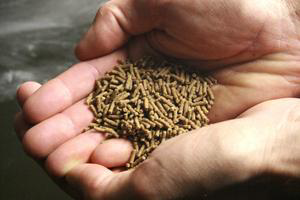BLOG: What is in our fish feed and fish?

A comment a Chinese jade perch farmer had made got me thinking. He was concerned about the fact that the jade perch he had tested at his local university didn’t match the Omega-3 fatty acid levels he had read about when the fish had been tested in Australia.
During the process I came across a 2010 piece by Andrew Jackson, Ph D. He’s the Technical Director of the International Fishmeal & Oil Organisation based in the UK. It’s worth looking up if you haven’t already seen it. It covers a lot of ground. In summary he says “Despite forecasts pointing to looming “traps” regarding fishmeal and fish oil, varied evidence demonstrates that, despite the fact that fishmeal and fish oil production is not increasing, their prices are remaining relatively stable against alternative ingredients. Also, for the last few years, the amount of fishmeal and fish oil used in aquaculture has remained static, while output from aquaculture has continued to increase.”
True, not all aquaculture production uses feed. The Chinese are said, especially by state bodies tasked with increasing output, to produce around half the global aquaculture output, of which a healthy percentage is – based on tonnage – seaweed. Then of course there’s the filter feeding molluscs. Again by tonnage, their shells punch them up to prominence amongst seafood that doesn’t have to be fed, and whose output is increasing.
But leave that aside, because it’s not the main element of the article that I wanted to highlight. As fishmeal and fish oil prices have escalated substitutes have been sought. The options, due to fishes’ poor ability to utilise carbohydrates, are limited. Soymeal, at a price, replaces fishmeal and canola oil replaced fish oil. The article has some interesting price comparisons, which commodity traders and futurologists may read something into, but generally speaking they march in unison.
What I found most noteworthy was the following quote. In relation to dietary compilation Andrew said, “The performance of the fish is generally not impaired but, importantly, the levels of health-giving fatty acids in the finished farmed product are reduced.” Let me repeat that – the levels of health-giving fatty acids in the finished farmed product are reduced.
Andrew goes on to say, “This reduction is important in markets where fish are seen as an excellent source of these critical nutrients, and medical opinion is agreed that the diets of the populations in many countries are deficient in them.”
Interestingly, in the 1960s almost all the annual production of 3 million metric tonnes of fishmeal were used in pig & poultry rations. By 2004 the call on the by then 5mmt annual production of fishmeal was from the aquaculture industry. The usage since then has remained static but aquaculture production of finfish has increased significantly. You do the sums.
Now I’m not sure if I’m writing this as a fish farmer or a consumer, probably a bit of both, but my main point is, what are we really getting in our fish feed and our fish? And if production isn’t compromised, as a fish farmer, does it matter what the ingredients are? After all, it’s a kilos in kilos out game. Always has been. So if performance doesn’t fall away, there’s no alarm bells ringing from the farm. The fish look the same and they tastes the same – presumably – but what about the nutritional claims we’re making for our product? When it comes to Omega-3 content, are we leaving ourselves wide open? Wide open on two counts: false advertising and the howling attacks of the eco-warriors who already have our industry targeted as aquatic agent orange – and will grab any whip with which to lash us?











